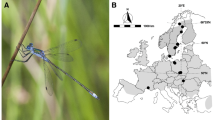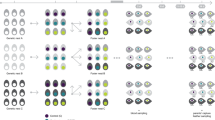Abstract
The genetic basis for determination of flight capacity in the light brown apple month, Epiphyas postvittana (Walker) (Tortricidae), was investigated by means of heritability estimation, artificial selection and crossbreeding, using samples from two natural populations. The mean heritabilities estimated by offspring-parent regression were 0.559 for offspring on female parents and 0.427 for offspring on male parents. These results were largely consistent with those estimated from paternal half-sibs and with realized heritabilities calculated from selected generations, although the heritability of flight capacity varied, to some extent, with the populations and temperatures to which the individuals were subjected. These estimates indicate the existence of additive genetic variance for flight capacity in the natural populations. The response pattern in the selection experiment indicates that the genetic effect on flight capacity in this species is mainly additive, though the phenotype performance of flights in F1 progeny from crossbreeding ‘long-fliers’ with ‘short-fliers’ suggests a weak dominance of short-flying genes and a slight maternal effect.
Similar content being viewed by others

Article PDF
References
Barker, J S F, and Thomas, R H. 1987. A quantitative genetic perspective on adaptive evolution. In: Loeschcke, V. (ed.) Genetic Constraints on Adaptive Evolution, Springer-Verlag, Berlin, pp. 3–23.
Becker, W A. 1984. Manual of Quantitative Genetics 4th edn, Academic Enterprises, Pullman, Washington.
Caldwell, R L, and Hegmann, J P. 1969. Heritability of flight duration in the milkweed bug Lygaeus kalmii. Nature, 223, 91–92.
Clark, L R. 1970. Analysis of pest situations through the life system approach. In: Rabb, R. L. and Guthrie, F. E. (eds) Concepts of Pest Management, North Carolina State University Press, Raleigh. RC.
Danthanarayana, W. 1975. The bionomics, distribution, and host range of the light brown apple moth, Epiphyas postvittana (Walk.) (Tortricidae). Amt J Zool, 23, 419–437.
Danthanarayana, W. 1976a. Diel and lunar flight periodicities in the light brown apple moth, Epiphyas postvittana (Walker) (Tortricidae) and their possible adaptive significance. Aust J Zool, 24, 65–73.
Danthanarayana, W. 1976b. Flight thresholds and seasonal variations in flight activity of the light brown apple moth, Epiphyas postvittana (Walker) (Tortricidae). Oecologia, 23, 171–182.
Danthanarayana, W. 1983. Population ecology of the light brown apple moth; Epiphyas postvittana (Lepidoptera: Tortricidae). J Anim Ecol, 52, 1–33.
Danthanarayana, W, Hamilton, J G, and Khoul Shyama, P. 1982. Low density larval crowding in the light brown apple moth, Epiphyas postvittana (Lepidoptera: Tortricidae) and its ecological significance. Entomol Exp Appl, 31, 352–358.
Dingle, H. 1986. Evolution and genetics of insect migration. In: Danthanarayana, W. (ed.) Insect Flight: Dispersal and Migration, Springer-Verlag, Berlin.
Dingle, H, Brown, C K, and Hegmann, J P. 1977. The nature of genetic variance influencing photoperiodic diapause in a migrant insect, Oncopeltus fasciatus Am Nat 111, 1047–1059.
Falconer, D S. 1981. Introduction to Quantitative Genetics, 2nd edn, Longman, London.
Gatehouse, A G. 1989. Genes, environment, and insect flight. In: Goldworthy, G. J. & Wheeler, C. H. (eds) Insect Flight, CRC Press Inc., Boca Raton, Florida.
Geier, P W, and Briese, D T. 1981. The light brown apple moth, Epiphyas postvittana (Walker): a native leafroller fostered by European settlement. In: Kitching, R. L. and Jones, F. E. (eds) The Ecology of Pests: Some Australian Case Histories. CSIRO Australia, Melbourne.
Green, G W. 1962. Flight and dispersal of the European pine shoot moth, Rhyacionia buoliana (Schiff.) I. Factors affecting flight and the flight potential of females. Can Ent, 94, 282–299.
Green, G W, and Pointing, P J. 1962. Flight and dispersal of the European pine shoot moth, Rhyacionia buoliana (Schiff.) II. Natural dispersal of egg-laden females. Can Ent, 94, 299–314.
Greenbank, D O, Schaefer, G W, and Rainey, R C. 1980. Spruce budworm (Lepidoptera: Tortricidae) moth flight and dispersal: New understanding from canopy observations, radar, and aircraft. Mem Ent Soc Can, 110, 1–49.
Gu, H, and Danthanarayana, W. 1990. Age-related flight and reproductive performance of the light brown apple moth, Epiphyas postvittana. Entomol Exp Appl, 54, 109–115.
Gu, H, and Danthanarayana, W. 1991. Quantitative genetic analysis of dispersal in Epiphyas postvittana. II. Genetic covariations between flight capacity and life-history traits. Heredity, 68, 61–69.
Harrington, R, and Taylor, L R. 1990. Migration for survival: fine-scale population redistribution in an aphid, Myzus persicae. J Anim Ecol, 59, 1177–1193.
Hartl, D L. 1980. Principles of Population Genetics, Sinauer Associates, Inc., Sauderland. MA.
Harvey, W R. 1970. Estimation of variance and covariance components in the mixed model. Biometrics, 26, 485–504.
Harvey, W R. 1988. User's Guide for LSMLMW Mixed Model Least-squares and Maximum Likelihood Computer Program. Ohio State Univ., Columbus, Ohio.
Hoffmann, R J. 1978. Environmental uncertainty and evolution of physiological adaptation in Colias butterflies. Am Nat, 112, 999–1015.
Kennedy, J S. 1961. A turning point in the study of insect migration. Nature, 189, 785–791.
McClearn, G E. 1967. Genes generality and behavioural research. In: Hirsch, J. (ed.) Behavior Genetic Analysis, McGraw-Hill, New York.
Møller, H, Smith, R H, and Sibly, R M. 1989. Evolutionary demography of a bruchid beetle. I. Quantitative genetical analysis of the female life history. Func Ecol, 3, 673–681.
Parker, W E, and Gatehouse, A G. 1985. Genetic factors controlling flight performance and migration in the African armyworm moth, Spodoptera exempta (Walker) (Lepidoptera: Noctuidae). Bull Ent Res, 75, 49–63.
Shorey, H H, and Hale, R L. 1965. Mass-rearing of the larvae of nine noctuid species on a simple artificial medium. J Econ Ent, 58, 522–524.
Sokal, R R, and Rohlf, F J. 1981. Biometry, 2nd edn, W. H. Freeman & Co., San Fransisco.
Southwood, T R E. 1962. Migration of terrestrial arthropods in relation to habitat. Biol Rev, 37, 171–214.
Taylor, L R, and Taylor, R A J. 1983. Insect migration as a paradigm for survival. In: Swingland, I. R. & Greenwood, P. W. (eds) The Ecology of Animal Movement. Clarendon Press, Oxford.
Van Valen, L. 1971. Group selection and the evolution of dispersal. Evolution, 25, 591–598.
Author information
Authors and Affiliations
Rights and permissions
About this article
Cite this article
Gu, H., Danthanarayana, W. Quantitative genetic analysis of dispersal in Epiphyas postvittana. I. Genetic variation in flight capacity. Heredity 68, 53–60 (1992). https://doi.org/10.1038/hdy.1992.7
Received:
Issue Date:
DOI: https://doi.org/10.1038/hdy.1992.7
Keywords
This article is cited by
-
A role for artificial night-time lighting in long-term changes in populations of 100 widespread macro-moths in UK and Ireland: a citizen-science study
Journal of Insect Conservation (2018)
-
Heritability of dispersal rate and other life history traits in the Glanville fritillary butterfly
Heredity (2008)
-
Quantitative genetic analysis of dispersal in Epiphyas postvittana. II. Genetic covariations between flight capacity and life-history traits
Heredity (1992)


